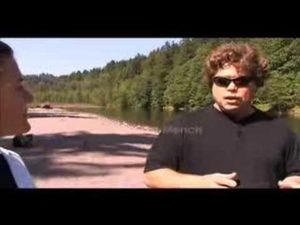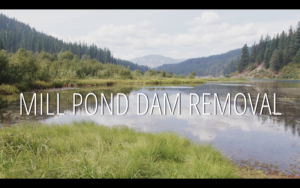GreenGen Mokelumne Pumped Storage Project
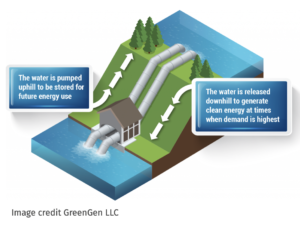
GreenGen LLC recently released an annual progress report for its proposed Mokelumne Pumped Storage Project P-14796, which outlined activities over the past year and announced that it expects to file a draft pre-application document (PAD) with the Federal Energy Regulatory Commission (FERC) by early April 2022. To provide background, this project is a proposed pumped storage hydropower system that would be located on the Upper Mokelumne River. The project will pump water from Salt Springs Reservoir up to Lower Bear River Reservoir when renewable electric generation exceeds customer load on the grid and electricity prices are low. Then it will deliver water from Lower Bear River Reservoir down to Salt Springs Reservoir and generate electricity when customer load exceeds renewable generation and prices are high, typically between about 4 pm to 9 pm.
Foothill Conservancy is concerned about the adverse environmental effects, including reduced water quality, the impacts to recreation, wildfire risk, and the overall feasibility of this project and wants to ensure our community is aware of the potential impacts associated with this project. Many members of our community use these reservoirs to recreate, and in addition to suffering the impacts of significant daily fluctuations in the reservoir level, this project could involve covering Lower Bear River Reservoir with solar panels in an attempt to mitigate the increased water temperatures that would result from this project. The increased water temperatures would also impact the sensitive fish and amphibian species that live in the Mokelumne River such as the Foothill Yellow-Legged Frog.
We understand the need for more reliable sources of power generation, however, we believe there are less destructive ways to generate power than pumped storage projects. For example, improvements to the outdated canals within the Amador Water Agency’s system could produce an estimated water savings of 1,250 acre feet per year. By saving water, it would allow more water to flow down the Mokelumne River and produce power through the already established Mokelumne River Hydroelectric Project.
Please stay tuned for announcements related to GreenGen and contact Foothill Conservancy at meredith@foothillconservancy.org if you would like to be added to the Mokelumne Pumped Storage Project contact list.
Underrepresented Communities Household Water Efficiency Project
Foothill Conservancy recently submitted a grant application for our Underrepresented Communities (URC) Household Water Efficiency Project through the Mokelumne Amador Calaveras Integrated Regional Water Management (MAC IRWM) group. If approved, this project would provide household water efficiency upgrades to participating members of Amador and Calaveras counties’ URC’s. Examples of upgrades include direct install of efficient plumbing appliances, leak detection and repair, and landscape irrigation improvements. The goal of this project is to help URC’s reduce their consumption and costs, which is especially important during times of drought, by providing them with household efficiency upgrades that will help them save water and save money on water costs.
Social and Ecological Resilience Across the Landscape (SERAL) Project
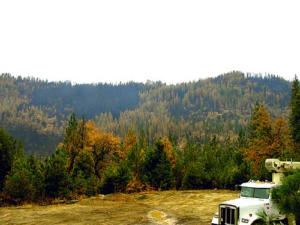
At the end of January, Foothill Conservancy submitted comments about the Social and Ecological Resilience Across the Landscape (SERAL) Draft Environmental Impact Statement (DEIS). The SERAL Project is a landscape scale forest treatment plan that would cover activities over 116,000 acres of Forest Service land within the Stanislaus National Forest. The goal of this project is to increase the social and ecological resilience of our forests in the face of climate change.
The SERAL Project proposes project-specific forest plan amendments that would change how California Spotted Owl habitats are managed, and other treatments such as forest thinning, fuel reduction, prescribed fire, fuel break maintenance and construction, hazard tree abatement, temporary road construction, herbicide use, and the use of condition based management for the salvage logging of trees killed by drought, insects/disease and wildfire.
We recognize the need to increase the pace and scale of forest treatments, however, we do not want this to lead to the loss of protections for our communities, large trees, and sensitive species that have habitat in the SERAL project area. We will continue to be involved in this project as the final documents are being prepared and we hope to see a decision later this year.
Forest Projects Plan feedback
The Upper Mokelumne River Watershed Authority’s (UMRWA) Forest Projects Plan (FPP), which is separated into two phases, is another forest treatment project we are providing feedback on. Phase One is set to be implemented by the end of this year, and would consist of “mutually agreeable” ladder fuels treatments of small diameter trees over a 10,000-acre project area in the Amador Ranger District. Phase Two will incorporate the Calaveras Ranger District into the project area and require a much more comprehensive planning document. The goal is to provide landscape level fire resilience and forest health to the National Forest lands in the Mokelumne River Watershed. Landscape level means that instead of treating small areas and performing environmental review for each small project, they want to treat the whole landscape by connecting old fuel breaks, treating larger areas than they have previously, and using one environmental document to cover the whole project area.
UMRWA is seeking feedback from Foothill Conservancy and other members of the forest collaborative known as the Amador Calaveras Consensus Group (ACCG) before it allows public comment, so they can limit controversy over the final plan. Please stay tuned for future public comment opportunities, and know that our feedback will be focused on keeping our communities and local environments safe and healthy.
Foothill Yellow-Legged Frog proposed endangered species listing comments
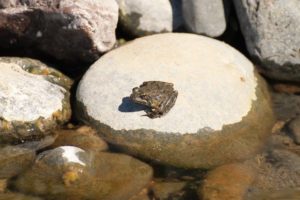
Foothill Conservancy will also be providing comments on the Foothill Yellow-Legged Frog (FYLF) proposed federal endangered species listing. The population of frogs in the Mokelumne River is proposed to be listed as endangered as a part of the South Sierra Distinct Population Segment (DPS). This listing would increase protections for the species as threats such as climate change, large wildfires, and water management threaten to diminish their population even further. Our comments will be focused on providing information about the Mokelumne River FYLF population in order to support the listing. We have information about their threats, breeding habits and behaviors, egg mass data, and information about current management strategies that could be adapted to help protect the frogs. We hope to see a successful listing which will eventually be followed by protecting critical FYLF habitat located along important riparian areas all across the Sierra Nevada foothills.
These are only some of the things the Foothill Conservancy’s Watershed Team is currently involved in. Our goal is to be involved with any decision that may impact the health of the Mokelumne River, Amador and Calaveras counties, and provide our supporters with updates and opportunities to get involved. We will continue to keep you informed about these projects and don’t hesitate to let us know if you have any questions.
Meredith Sierra
Watershed Conservation and Land-Use Advocate

